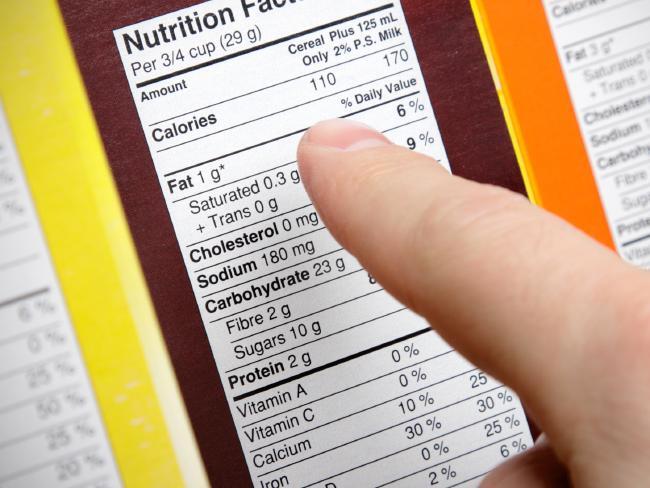NEW analysis has found seven out of 10 packaged foods sold on Australian supermarket shelves contain added sugar, all of which isn’t clearly declared on the front of packaging.
Soft drinks, cakes, pies, ice cream, pastries and processed meats are the worst offenders. On average they contain four times more added sugar than plain cereals or oats.
The findings of the analysis from the George Institute for Global Health at the University of NSW, published in the journal Nutrients, have led to calls for manufacturers to declare the amount of added sugar on the packaging.
“Good sugars are an integral part of a healthy diet, and we need to be able to separate sugars naturally present in dairy, fruits and vegetables from sugars added during manufacturing,” said the Institute’s Professor Bruce Neal.
‘‘Added sugars are empty calories and a major contributing factor to the obesity epidemic and tooth decay,” he said.
The Health Star Rating (HSR) is a front-of-pack labelling system that rates the overall nutritional profile of packaged foods.
According to Nutrition, the algorithm underpinning the HSR includes total sugar content as one of the components. But this has been criticised because intrinsic sugars naturally present in dairy, fruits, and vegetables are treated the same as sugars added during food processing.
In Australia, two out of three adults are considered overweight or obese, while one in four children fall in to the same category.
In 2011-12 Australians consumed on average 60 grams (14 teaspoons) of added sugar a day. This equates to almost 22 kilos of added sugar a year.
A spokesman from the Dietitians Association of Australia told news.com.au the body “supports” the inclusion of labels showing added sugar to nutrition panels.
“Understanding nutrition labels can be complex,” the spokesman said.
“The DAA supports efforts to cut down the confusion — such as including added sugar to nutrition information panels — which could make choosing healthier options easier in the supermarket.
“Any effort to improve nutrition labelling needs to be coupled with education on how to interpret it, and health professionals like Accredited Practising Dietitians are well placed to provide practical information on understanding food labels, and making healthy food choices.”
Nutritionist Kristen Beck told news.com.au that manufacturers often include sugars that “sound healthy” — but are actually empty ingredients.
“The Health Star Rating’s failure to differentiate between added sugars, and sugars that are naturally occurring in core foods such as fruits and dairy mean that consumers are not in a position to make informed decisions about the healthiness of the product,” she said.
“Manufacturers also tend to use added sugars that sound healthy, such as fruit juice concentrates, honey, rice malt syrups etc, however the World Health Organisation deems all of these as “free sugars” and advises that no more that 10% — but ideally less than 5% — of your total energy intake should come from these.”
Researchers analysed more than 34,000 packaged foods — more than 18,000 discretionary foods and nearly 16,000 core foods like milk, bread and cheese. Based on the Australian Dietary Guidelines, a significantly higher proportion of discretionary foods contained added sugar compared to core foods, 87 per cent versus 52 per cent.
Knowing how much added sugar is in your food is unclear, unless you check the ingredients listing. The higher up on the list ‘sugar’ appears, the more sugar the product contains. But according to Choice, sugar can be disguised under more than 40 different names — so it’s not always straightforward.
In April, Choice called on Food and Health Ministers to have added sugar clearly labelled on food products.
The research will be submitted to the federal government’s current review of the Health Star Rating (HSR) system.
Professor Neal says the HSR system, which was introduced in 2014, gives consumers great advice most of the time, but only labelling total sugar content as opposed to added sugar can be misguiding.
This is particularly so for discretionary products such as muesli bars, jam, rice puddings, and chutney and other sauces and spreads, which contain a lot of added sugar but get a relatively high HSR in the current system.
For example, a 250ml of Sanitarium’s Chocolate Up & Go has a 4.5 HSR, but contains 19.2g of sugar.
A 200g box of Kellog’s Nutrigrain cereal, which has a 4 HSR, contains 64g of sugar in total.
And for a 200ml Just Juice orange popper, with a Health Star Rating of 5 — you’re looking at 16g of sugar per serve.
Earlier this year, consumer group Choice released a report which found that if consumers could identify added sugars on food packs they could avoid 26 teaspoons of sugar each day.
With 50 per cent of Australian adults consuming more added sugar than they should, there is a clear need for improved labelling, Prof Neal said.
“We’d encourage food manufacturers to start labelling added sugars and government to provide the framework,” he said.
“Australians would be much better off if they could quickly and easily see how much sugar has been added.”
Source: http://bit.ly/2v2wH7O











